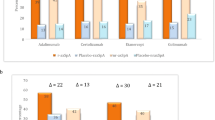Abstract
Axial spondyloarthritis (axSpA), a chronic inflammatory condition that encompasses radiographic (also known as ankylosing spondylitis [AS]) and non-radiographic (nr-axSpA) forms of the disease (Rudwaleit et al. Ann Rheum Dis 68:777–783, 2009), can lead to chronic pain, structural damage, and disability. While understanding of the pathophysiology of axSpA and its management (classification, diagnosis, monitoring, and treatment) has increased over recent years (Sieper and Poddubnyy Lancet (london, England). 390:73–84, 2017), still relatively little is known about the disease from the perspective of the patient.
You have full access to this open access chapter, Download chapter PDF
Similar content being viewed by others
Axial spondyloarthritis (axSpA), a chronic inflammatory condition that encompasses radiographic (also known as ankylosing spondylitis [AS]) and non-radiographic (nr-axSpA) forms of the disease (Rudwaleit et al. 2009), can lead to chronic pain, structural damage, and disability. While understanding of the pathophysiology of axSpA and its management (classification, diagnosis, monitoring, and treatment) has increased over recent years (Sieper and Poddubnyy 2017), still relatively little is known about the disease from the perspective of the patient. Further research efforts are required to better understand the patient journey to diagnosis, the functional limitations associated with living with axSpA, and its effects on work productivity, quality of life, and psychological well-being (Garrido-Cumbrera et al. 2017).
The International Map of Axial Spondyloarthritis (IMAS) European project, a collaboration between the Health & Territory Research (HTR) group of the University of Seville, the Axial Spondyloarthritis International Federation (ASIF), the Spanish Federation of Spondyloarthritis Associations (CEADE), a steering committee composed of patient representatives and internationally recognized rheumatologists, psychologists, and physiotherapists specialized in the field of axSpA, and Novartis, was conceived to address these unmet needs (Fig. 1.1) (Garrido-Cumbrera et al. 2019a).
IMAS has an overarching aim of expanding our knowledge of axSpA to raise awareness of the impact of the disease on patients. The hope is that the data gathered will help inform long-term plans and treatment goals to ultimately improve quality of life and optimize clinical outcomes for patients, while fostering closer relationships between patient organizations, healthcare professionals (HCPs), and policy makers across Europe.
As part of the IMAS European project, a detailed questionnaire was conducted to gather data from patients with axSpA across 12 European countries: Austria, Belgium, France, Germany, Italy, the Netherlands, Norway, Slovenia, Sweden, Switzerland, Russia, and the UK. In 8 of the 12 participating countries (all except Austria, Belgium, Germany, and the UK), country-specific steering committees supported local interpretation and dissemination of the data. The survey results provide a snapshot of the current status of axSpA across Europe and build upon the pilot questionnaire conducted as part of the Atlas of Ankylosing Spondylitis in Spain 2017 (Garrido-Cumbrera et al. 2019b), the data from which were added to the IMAS database retrospectively. Since its publication, the Atlas of axSpA in Spain has been used to support discussions with the Spanish health authorities (Autonomous Communities of Madrid, Catalonia, Andalusia, Basque Country and Castille La-Mancha) to put axSpA on the health policy agenda and implement solutions at the national level that improve patients’ health.
This International Atlas of Axial Spondyloarthritis 2020 presents the key data from the IMAS questionnaire. The results are arranged thematically and have been critically analyzed, reviewed, and interpreted by the IMAS expert steering committee.
References
Garrido-Cumbrera M, Hillmann O, Mahapatra R, et al. Improving the management of psoriatic arthritis and axial spondyloarthritis: roundtable discussions with healthcare professionals and patients. Rheumatol Ther. 2017;4:219–31.
Garrido-Cumbrera M, Poddubnyy D, Gossec L, et al. The European map of axial spondyloarthritis: capturing the patient perspective-an analysis of 2846 patients across 13 countries. Curr Rheumatol Rep. 2019a;21:19.
Garrido-Cumbrera M, Navarro-Compan V, Zarco P, et al. Atlas of axial spondyloarthritis in Spain 2017: study design and population. Reumatol Clin. 2019b;15:127–32.
Rudwaleit M, van der Heijde D, Landewe R, et al. The development of assessment of Spondyloarthritis international society classification criteria for axial spondyloarthritis (part II): validation and final selection. Ann Rheum Dis. 2009;68:777–83.
Sieper J, Poddubnyy D. Axial spondyloarthritis. Lancet (London, England). 2017;390:73–84.
Author information
Authors and Affiliations
Consortia
Rights and permissions
Open Access This chapter is licensed under the terms of the Creative Commons Attribution 4.0 International License (http://creativecommons.org/licenses/by/4.0/), which permits use, sharing, adaptation, distribution and reproduction in any medium or format, as long as you give appropriate credit to the original author(s) and the source, provide a link to the Creative Commons license and indicate if changes were made.
The images or other third party material in this chapter are included in the chapter's Creative Commons license, unless indicated otherwise in a credit line to the material. If material is not included in the chapter's Creative Commons license and your intended use is not permitted by statutory regulation or exceeds the permitted use, you will need to obtain permission directly from the copyright holder.
Copyright information
© 2022 The Author(s)
About this chapter
Cite this chapter
Garrido-Cumbrera, M. et al. (2022). Introduction. In: Axial Spondyloarthritis: Patient-Reported Impact in Europe. Springer, Cham. https://doi.org/10.1007/978-3-030-97606-4_1
Download citation
DOI: https://doi.org/10.1007/978-3-030-97606-4_1
Published:
Publisher Name: Springer, Cham
Print ISBN: 978-3-030-97605-7
Online ISBN: 978-3-030-97606-4
eBook Packages: MedicineMedicine (R0)





